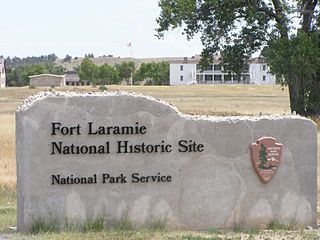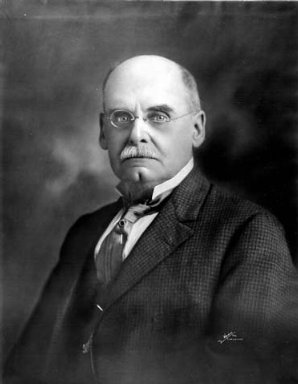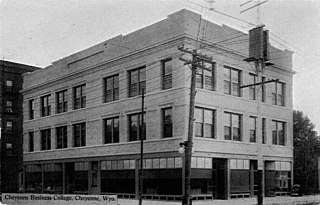
The Grattan Massacre, also known as the Grattan Fight, was the opening engagement of the First Sioux War, fought between the United States Army and Lakota Sioux warriors on August 19, 1854. It occurred east of Fort Laramie, Nebraska Territory, in present-day Goshen County, Wyoming.

Fort Laramie was a significant 19th-century trading post, diplomatic site, and military installation located at the confluence of the Laramie and the North Platte Rivers. They joined in the upper Platte River Valley in the eastern part of the present-day U.S. state of Wyoming. The fort was founded as a private trading-post in the 1830s to service the overland fur trade; in 1849, it was purchased by the United States Army. The site was located east of the long climb leading to the best and lowest crossing-point over the Rocky Mountains at South Pass and became a popular stopping-point for migrants on the Oregon Trail. Along with Bent's Fort on the Arkansas River, the trading post and its supporting industries and businesses were the most significant economic hub of commerce in the region.

The Bozeman Trail was an overland route in the Western United States, connecting the gold rush territory of southern Montana to the Oregon Trail in eastern Wyoming. Its most important period was from 1863 to 1868. Despite the fact that the major part of the route in Wyoming used by all Bozeman Trail travelers in 1864 was pioneered by Allen Hurlbut, it was named after John Bozeman. Many miles of the Bozeman Trail in present Montana followed the tracks of Bridger Trail, opened by Jim Bridger in 1864.

Thomas Moonlight was an American politician and soldier. Moonlight served as Governor of Wyoming Territory from 1887 to 1889.

Stephen Wheeler Downey was a lawyer and politician in Wyoming. A Union Army veteran of the American Civil War, he was an early white settler of Wyoming, and served as its treasurer, auditor, and delegate to Congress. After statehood, Downey continued to serve in local and state office, including Speaker of the Wyoming House of Representatives.

Jacques La Ramée was a French-Canadian and Métis coureur des bois, frontiersman, trapper, fur trader, hunter, explorer, and mountain man who lived in what is now the U.S. state of Wyoming, having settled there in 1815. His name appears in several spellings, including La Ramee, Laramée, LaRamée, La Ramie, La Rami, La Remy, and Laramie. La Ramée is credited as an early explorer of what is now called the Laramie River of Wyoming and Colorado. The city of Laramie, Wyoming, with an Americanized spelling, was later named for him.
A private in the Fourth Infantry, Charles Howard served as photographer for the Stanton Expedition in 1877, traveling throughout eastern Wyoming, western Nebraska and into the Black Hills of Dakota Territory.
Galvanized Yankees was a term from the American Civil War denoting former Confederate prisoners of war who swore allegiance to the United States and joined the Union Army. Approximately 5,600 former Confederate soldiers enlisted in the United States Volunteers, organized into six regiments of infantry between January 1864 and November 1866. Of those, more than 250 had begun their service as Union soldiers, were captured in battle, then enlisted in prison to join a regiment of the Confederate States Army. They surrendered to Union forces in December 1864 and were held by the United States as deserters, but were saved from prosecution by being enlisted in the 5th and 6th U.S. Volunteers. An additional 800 former Confederates served in volunteer regiments raised by the states, forming ten companies. Four of those companies saw combat in the Western Theater against the Confederate Army, two served on the western frontier, and one became an independent company of U.S. Volunteers, serving in Minnesota.
The 1958 Wyoming Cowboys football team was an American football team that represented the University of Wyoming as a member of the Skyline Conference during the 1958 NCAA University Division football season. In their second year under head coach Bob Devaney, the Cowboys compiled an 8–3 record, won the Sun Bowl over Hardin–Simmons, and outscored opponents by a total of 205 to 136. They played their home games at War Memorial Stadium in Laramie, Wyoming.
The 1955 Wyoming Cowboys football team was an American football team that represented the University of Wyoming as a member of the Skyline Conference during the 1955 college football season. In their third year under head coach Phil Dickens, the Cowboys compiled a record of eight wins and three losses, defeated Texas Tech in the 1956 Sun Bowl, and outscored opponents by a total of 225 to 137. They played their home games at War Memorial Stadium in Laramie, Wyoming.

The following works deal with the cultural, political, economic, military, biographical and geologic history of pre-territorial Wyoming, Wyoming Territory and the State of Wyoming.

Gibson Clark was an American jurist who served as a justice of the Wyoming Supreme Court from January 2, 1893, to September 22, 1894. He would resign that position in order to become the first official US Attorney for the District of Wyoming. He was born in Clarke County, Virginia and served in the Confederate Army during the American Civil War.
Bordeaux is an unincorporated community in Platte County, Wyoming, United States.
Wyoming Pioneer Association is an organization that aims to preserve Wyoming's pioneer history. The association was formed in 1884 and incorporated in 1926 in a small pioneer cabin located on the Wyoming State Fairgrounds in Douglas; the Wyoming legislature appropriated funds for construction of a museum at the same location in 1956, and the association expanded its facilities in 2013 to add the Ruthe James Williams Center.

Kathleen Marie Karpan is an American politician who served as secretary of state of Wyoming from 1987 to 1995, and as the director of the federal Office of Surface Mining Reclamation and Enforcement from 1997 to 2000. A member of the Democratic Party, she unsuccessfully ran for Wyoming's governor and United States senator as the Democratic nominee in 1994 and 1996, respectively. She is the most recent Democrat to serve as Wyoming Secretary of State.
The 1931 Colorado Agricultural Aggies football team represented Colorado Agricultural College in the Rocky Mountain Conference (RMC) during the 1931 college football season. In their 21st season under head coach Harry W. Hughes, the Aggies compiled a 5–4 record, tied for second place in the RMC, and were outscored by a total of 138 to 137.
The 1963 Wyoming Cowboys football team was an American football team that represented the University of Wyoming as a member of the Western Athletic Conference (WAC) during the 1963 NCAA University Division football season. In their second season under head coach Lloyd Eaton, the Cowboys compiled a 6–4 record, finished fifth in the WAC, and outscored opponents by a total of 191 to 152. Mack Balls and Tom Delaney were the team captains.

Cheyenne Business College was a trade school in Cheyenne, Wyoming that existed in the early 20th century.

Eppa Hunton III, known as Eppa Hunton Jr., was an American lawyer, railroad executive, and politician. The son of General Eppa Hunton, he experienced a turbulent childhood with the American Civil War and Reconstruction as its backdrop. After graduating from the University of Virginia School of Law, he practiced law with his father in Warrenton, Virginia, for a number of years before moving south to Richmond in 1901 to help found the law firm Munford, Hunton, Williams & Anderson.

Henry Evelith Maynadier was a United States Army officer known for his field work in Montana during the Raynolds Expedition and his work to set up peace talks with the Oglala and Brulé tribes at Fort Laramie in 1866. He served in the Union Army during the American Civil War.












